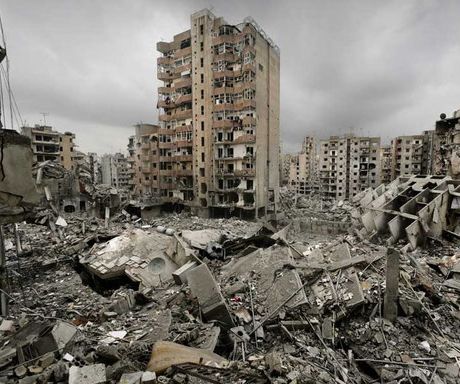 Military conflicts have caused huge death toll and enormous economic, military, environmental, social and political losses for Arabs since 1948.
Military conflicts have caused huge death toll and enormous economic, military, environmental, social and political losses for Arabs since 1948.
With more than 2 million death toll, Arab economies, mainly Iraq, Syria, Yemen, Sudan, Lebanon, Jordan and North Africa countries have lost up to $11 trillion since 1948. The first losses were a result of Arab-Israeli wars, the second was the eight-year Iran-Iraq war and the third was the Arab Spring.
Such conflicts have affected not only the countries per se but rather they have extended to neighboring countries, turning the entire region into a flaming ball, destructing trade, industry, tourism, and investment. This has led to massive exodus of citizens from rural areas to cities, resulting in ecological predicaments, desertification and drought.
For many years, the Middle East has been the scene of conflict, the worst conflicts in the world. This has been accompanied by arms race to purchase weapons.
That has been the case with the Middle East, where many countries sought to acquire the state-of-the art weaponry. Some recent studies estimated military spending in the Middle East for 2017 at $120 billion, an increase of 6 percent over 2016. Such papers indicate that the region accounts for an increase in the volume of military spending by 6 percent.
Balance of power
The balance of power in international politics is a highly complex and multifaceted concept, but there is an agreement on the broad lines theoretically and practically in the course of events. At present, the world has generally complex or multipolar balances; simple or binary poises.
The composite balance depends on multiple poles in each party, including states and blocs as it is dominated by the logic of competition and deterrence, and often avoids war, leading to stagnation and stability.
The current international conflict, although oriented toward a bilateral balance, is flexible due to absence of argumentative ideological factors
– Shehab Al-Makahleh
The simple balance is the most precarious as the blocs and alliances clash sharply leading to war and the period of stability is an impermanent period, which is the preparation for war and a test of how powerful such an alliance is.
Since the conflict is between two main blocs, each of which is controlled by a major nucleus state that makes the conflict look like an encounter between two major states. The same applies to regional balances but a regional power plays a dual role: an internal in the region and an external in international conflicts, where international engagements and developments depend on regional wars and balances.
Regional conflict for international wars
Given the gravity of major world wars because of nuclear deterrence, regional confrontations are the direct alternative, with each bloc supporting its allies in the region to gain a foothold and increase balance internationally.
The characteristics and nature of equilibrium are divided into rigid and elastic, where the rigid expresses a balance between heterogeneous and contradictory blocs while the flexible expresses a balance between relatively homogenous clusters of civilization, culture and ideology.
This explains why the Middle East and poor countries are witnessing non-stop wars since early 20th century. Given the current international and regional situation, one can say that since the collapse of the Berlin Wall as a sign of the end of the Cold War and the transformation of the world into unipolarity, balances have been constantly being shaped to counterbalance this imbalanced status. International and regional alliances have been formed to counter the Western bloc led by the US.
Due to multiple factors, coalitions have until recently formed balances of pluralistic, flexible and resilient types. Despite US President Donald Trump’s policies against many countries, including his allies in the West, power balance is flexible because Russia tends to be a nucleus power as well at the international level within its own bloc, using regional allies.
The source of flexibility is that the ideological factors are no longer the same as before, and a war like the Second World War which broke out in 1939 was to counter Nazism-Fascism ideologies. The demise of the Soviet Union and the offense against the USSR have broken out because of communist ideologies.
Bilateral balance
Thus, the current international conflict, although oriented toward a bilateral balance, is flexible due to absence of argumentative ideological factors. The two camps: Russia and its orbit on one hand and the US and its orbit on the other are pragmatic, and this will avert the two blocs from getting involved in another world war. Thus, a regional war is much more likely to happen.
However, the risks for the Middle East region are quite vibrant. Unlike the international community which is pragmatic, the Mideast regional balance comes from furthering ideological cognitive calculations into existential, which would lead to war anytime where each of the two blocs tests its policies, diplomacy and weaponry.
For Israel to launch a war, this is impossible to target any country except Syria, Lebanon and Iran. However, this necessitates that Tel Aviv seizes a rare regional moment that the whole region is undergoing to act. This cannot be achieved without a political and media cover. Right now, we are witnessing these two covers for Israel more than before.
Any future war could sweep through the entire region and undermine regional and international interests for years to come. Besides, countless implications on the people of the Middle East are projected. However, the Mideast is still an area where the major international blocs are testing their policies and state-of-the-art weaponry regardless of any Middle Easterners’ reaps that meet their aspirations and ambitions.
Article published in Al Arabiya: https://english.alarabiya.net/en/views/news/middle-east/2018/07/27/The-cost-of-Middle-East-wars-11-trillion-and-rising.html












